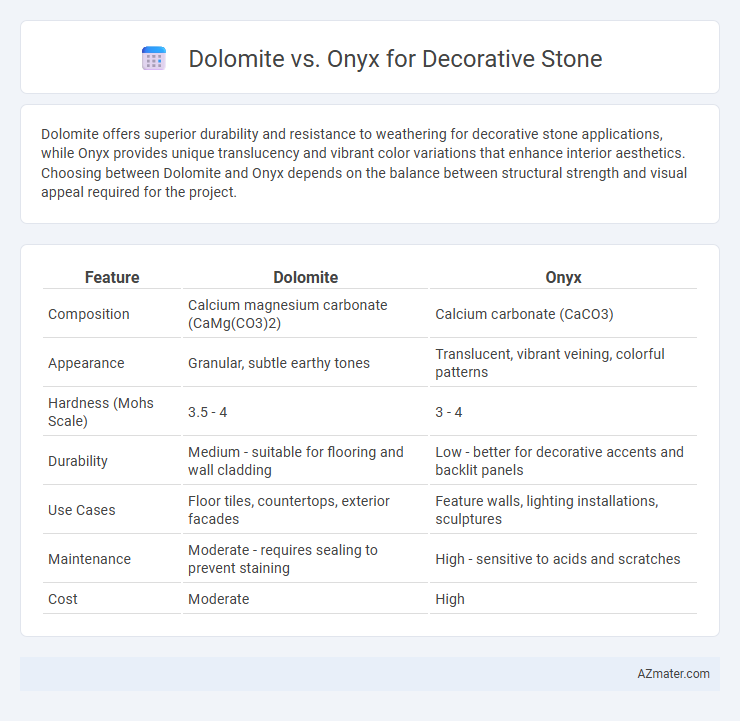Dolomite offers superior durability and resistance to weathering for decorative stone applications, while Onyx provides unique translucency and vibrant color variations that enhance interior aesthetics. Choosing between Dolomite and Onyx depends on the balance between structural strength and visual appeal required for the project.
Table of Comparison
| Feature | Dolomite | Onyx |
|---|---|---|
| Composition | Calcium magnesium carbonate (CaMg(CO3)2) | Calcium carbonate (CaCO3) |
| Appearance | Granular, subtle earthy tones | Translucent, vibrant veining, colorful patterns |
| Hardness (Mohs Scale) | 3.5 - 4 | 3 - 4 |
| Durability | Medium - suitable for flooring and wall cladding | Low - better for decorative accents and backlit panels |
| Use Cases | Floor tiles, countertops, exterior facades | Feature walls, lighting installations, sculptures |
| Maintenance | Moderate - requires sealing to prevent staining | High - sensitive to acids and scratches |
| Cost | Moderate | High |
Introduction to Dolomite and Onyx
Dolomite is a durable carbonate mineral composed primarily of calcium magnesium carbonate, prized for its resilience and subtle shades of white, gray, and pink in decorative stone applications. Onyx, a form of banded chalcedony, features striking translucent layers in hues ranging from deep amber to pure white, making it a luxurious choice for artistic and architectural details. Both stones offer unique aesthetic and physical properties, with dolomite favored for structural uses and onyx prized for its ornamental, light-enhancing qualities.
Geological Origins and Composition
Dolomite is a sedimentary carbonate rock composed primarily of the mineral dolomite (CaMg(CO3)2), formed through the diagenesis of limestone under magnesium-rich conditions, typically in shallow marine environments. Onyx is a variety of chalcedony, a cryptocrystalline form of quartz (SiO2), formed through the deposition of silica in gas cavities within volcanic rocks, creating its characteristic banded appearance. The fundamental geological distinction lies in dolomite's carbonate origin versus onyx's siliceous, volcanic formation, influencing their respective chemical compositions and physical properties in decorative stone applications.
Aesthetic Differences: Color and Patterns
Dolomite displays a muted, earthy palette of white, cream, and beige tones with subtle veining, lending a natural and understated elegance to decorative stone surfaces. Onyx offers a translucent quality with vibrant colors ranging from honey amber to emerald green, featuring striking banded patterns that create a dramatic visual impact. The choice between Dolomite and Onyx hinges on whether a soft, classic aesthetic or a bold, luminous design effect is desired for interior decor.
Durability and Hardness Comparison
Dolomite, with a Mohs hardness of 3.5 to 4, offers moderate durability making it suitable for indoor decorative applications resistant to scratches and wear. Onyx ranks lower in hardness, typically around 3, resulting in a more fragile surface prone to scratching and etching, thus requiring careful maintenance. For high-traffic decorative stone installations, dolomite provides superior resistance to impact and abrasion compared to onyx, which excels in aesthetics but demands cautious use to preserve its delicate finish.
Applications in Interior Design
Dolomite is favored in interior design for its durability and subtle, natural patterns, making it ideal for countertops, flooring, and wall cladding in kitchens and bathrooms. Onyx offers a striking translucent quality, often used for backlit feature walls, decorative panels, and luxury countertops to create a dramatic visual effect. Both stones enhance interior aesthetics but differ in applications: dolomite suits high-traffic areas needing resilience, while onyx excels in statement pieces requiring careful handling and maintenance.
Maintenance and Cleaning Requirements
Dolomite requires minimal maintenance, offering high resistance to scratches and stains, making it ideal for high-traffic areas with simple cleaning routines involving mild soap and water. Onyx, being softer and more porous, demands regular sealing and delicate care to prevent etching and discoloration, with maintenance focused on using pH-neutral cleaners and avoiding acidic substances. Both stones offer unique aesthetic qualities, but Dolomite's durability ensures lower long-term upkeep compared to the more fragile and maintenance-intensive Onyx.
Cost and Market Availability
Dolomite generally offers a more cost-effective option compared to onyx, making it popular for budget-conscious decorative stone projects. Onyx, prized for its unique translucency and vibrant colors, commands a higher price due to its rarity and complex extraction process. Market availability favors dolomite, which is widely accessible from numerous quarries, while onyx remains limited to select regions, impacting both supply and price stability.
Pros and Cons of Dolomite as Decorative Stone
Dolomite offers a durable and chemically stable option for decorative stone with excellent resistance to weathering and acid rain, making it ideal for outdoor use and architectural applications. Its fine-grained texture and subtle coloration provide an elegant appearance, but it can be more challenging to polish than other stones, such as onyx, and may have limited color variety. While dolomite is generally less expensive and more abundant than onyx, it lacks the translucent beauty and vibrant hues that make onyx a preferred choice for high-end interior design and decorative features.
Pros and Cons of Onyx as Decorative Stone
Onyx offers a unique translucency and striking veining patterns that create luxurious visual appeal in decorative stone applications, making it ideal for backlit panels and intricate designs. However, onyx is softer and more porous compared to dolomite, leading to higher susceptibility to scratching, staining, and etching from acids, which demands regular sealing and careful maintenance. Despite its delicate nature, onyx provides an unparalleled aesthetic that can elevate interior spaces where durability is less critical than artistic expression.
Choosing the Right Stone for Your Space
Dolomite offers durability and a subtle, crystalline texture ideal for high-traffic areas, while onyx provides a translucent, luxurious appearance perfect for accent walls and low-impact spaces. Consider the stone's hardness, maintenance needs, and visual impact when selecting between dolomite's resilience and onyx's unique light-transmitting qualities. Balancing functional demands with aesthetic preferences ensures the right decorative stone enhances both style and longevity in your space.

Infographic: Dolomite vs Onyx for Decorative Stone
 azmater.com
azmater.com